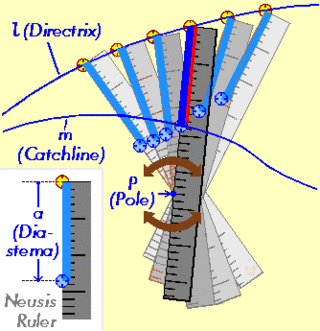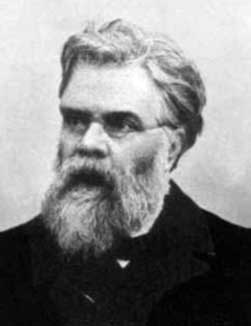
In geometry and algebra, a real number is constructible if and only if, given a line segment of unit length, a line segment of length can be constructed with compass and straightedge in a finite number of steps. Equivalently, is constructible if and only if there is a closed-form expression for using only integers and the operations for addition, subtraction, multiplication, division, and square roots.

In geometry, straightedge-and-compass construction – also known as ruler-and-compass construction, Euclidean construction, or classical construction – is the construction of lengths, angles, and other geometric figures using only an idealized ruler and a pair of compasses.

Doubling the cube, also known as the Delian problem, is an ancient geometric problem. Given the edge of a cube, the problem requires the construction of the edge of a second cube whose volume is double that of the first. As with the related problems of squaring the circle and trisecting the angle, doubling the cube is now known to be impossible to construct by using only a compass and straightedge, but even in ancient times solutions were known that employed other tools.

Angle trisection is a classical problem of straightedge and compass construction of ancient Greek mathematics. It concerns construction of an angle equal to one third of a given arbitrary angle, using only two tools: an unmarked straightedge and a compass.

In geometry, bisection is the division of something into two equal or congruent parts, usually by a line, which is then called a bisector. The most often considered types of bisectors are the segment bisector and the angle bisector.

Squaring the circle is a problem in geometry first proposed in Greek mathematics. It is the challenge of constructing a square with the area of a circle by using only a finite number of steps with a compass and straightedge. The difficulty of the problem raised the question of whether specified axioms of Euclidean geometry concerning the existence of lines and circles implied the existence of such a square.
The Huzita–Justin axioms or Huzita–Hatori axioms are a set of rules related to the mathematical principles of origami, describing the operations that can be made when folding a piece of paper. The axioms assume that the operations are completed on a plane, and that all folds are linear. These are not a minimal set of axioms but rather the complete set of possible single folds.

In mathematics, a constructible polygon is a regular polygon that can be constructed with compass and straightedge. For example, a regular pentagon is constructible with compass and straightedge while a regular heptagon is not. There are infinitely many constructible polygons, but only 31 with an odd number of sides are known.

In the branch of mathematics known as Euclidean geometry, the Poncelet–Steiner theorem is one of several results concerning compass and straightedge constructions having additional restrictions imposed on the traditional rules. This result states that whatever can be constructed by straightedge and compass together can be constructed by straightedge alone, provided that a single circle and its centre are given. This theorem is related to the rusty compass equivalence.

In geometry, a tridecagon or triskaidecagon or 13-gon is a thirteen-sided polygon.

In geometry, an arbelos is a plane region bounded by three semicircles with three apexes such that each corner of each semicircle is shared with one of the others (connected), all on the same side of a straight line that contains their diameters.
Pierre Laurent Wantzel was a French mathematician who proved that several ancient geometric problems were impossible to solve using only compass and straightedge.
In geometry, a trisectrix is a curve which can be used to trisect an arbitrary angle with ruler and compass and this curve as an additional tool. Such a method falls outside those allowed by compass and straightedge constructions, so they do not contradict the well known theorem which states that an arbitrary angle cannot be trisected with that type of construction. There is a variety of such curves and the methods used to construct an angle trisector differ according to the curve. Examples include:

In geometry, the neusis is a geometric construction method that was used in antiquity by Greek mathematicians.

In geometry, an octadecagon or 18-gon is an eighteen-sided polygon.

Émile Michel Hyacinthe Lemoine was a French civil engineer and a mathematician, a geometer in particular. He was educated at a variety of institutions, including the Prytanée National Militaire and, most notably, the École Polytechnique. Lemoine taught as a private tutor for a short period after his graduation from the latter school.
In Euclidean geometry, Apollonius' problem is to construct all the circles that are tangent to three given circles. Special cases of Apollonius' problem are those in which at least one of the given circles is a point or line, i.e., is a circle of zero or infinite radius. The nine types of such limiting cases of Apollonius' problem are to construct the circles tangent to:
- three points
- three lines
- one line and two points
- two lines and a point
- one circle and two points
- one circle, one line, and a point
- two circles and a point
- one circle and two lines
- two circles and a line
The Ancient Tradition of Geometric Problems is a book on ancient Greek mathematics, focusing on three problems now known to be impossible if one uses only the straightedge and compass constructions favored by the Greek mathematicians: squaring the circle, doubling the cube, and trisecting the angle. It was written by Wilbur Knorr (1945–1997), a historian of mathematics, and published in 1986 by Birkhäuser. Dover Publications reprinted it in 1993.
Geometric Constructions is a mathematics textbook on constructible numbers, and more generally on using abstract algebra to model the sets of points that can be created through certain types of geometric construction, and using Galois theory to prove limits on the constructions that can be performed. It was written by George E. Martin, and published by Springer-Verlag in 1998 as volume 81 of their Undergraduate Texts in Mathematics book series.














